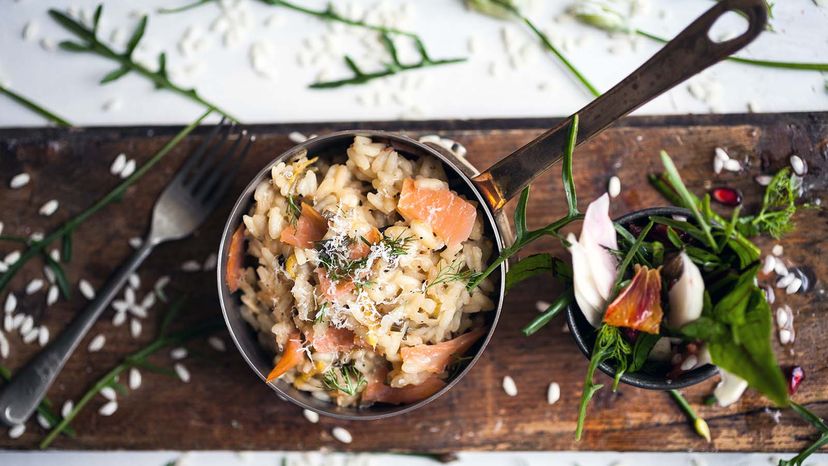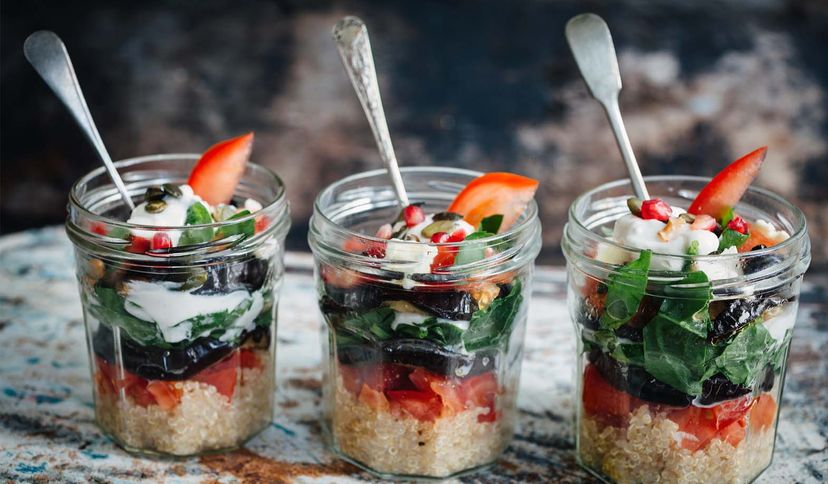 “This smoked salmon risotto is a quick, healthy low-FODMAP dish. Joan Ransley/Getty Images
“This smoked salmon risotto is a quick, healthy low-FODMAP dish. Joan Ransley/Getty Images
If you’re one of the 10 to 15 percent of people in the world with irritable bowel syndrome (IBS), you might think you’re doomed to a life of abdominal cramps, diarrhea, constipation or alternating episodes of both. But a growing body of evidence suggests that limiting your intake of fermentable oligosaccharides, disaccharides, monosaccharides and polyols — commonly known by the acronym FODMAP — may calm your fussy gut.
FODMAPs are short-chain carbohydrates found in many foods that either absorb too slowly or don’t digest at all in the small intestines. By the time these carbs reach the large intestines, they begin to ferment. For people with more sensitive guts, this creates gas, which stretches the intestines and causes bloating and pain.
The Low FODMAP Diet restricts foods that are high FODMAPs, then gradually reintroduces foods from different high FODMAP categories back into the diet in order to identify which foods trigger symptoms. Armed with this knowledge, those with IBS know what foods to avoid in order to stay symptom free.
What Are Low FODMAP Foods?
IBS has always been a tricky condition. Unlike celiac disease or inflammatory bowel disease, there are no diagnostic tests to positively identify it. Most people with symptoms were told to eat more fiber, eat less fiber or just avoid foods that gave them gas. Identifying those foods, however, was just as difficult.
But, in the 1990s, Australian dietitian Sue Shepherd began to notice that her patients with IBS were finding relief from their symptoms by avoiding foods that contained high levels of fructose (monosaccharides) and fructans (oliogosaccharides), such as honey, wheat breads, pasta, onions and certain fruits. She called this diet the "Fructose Malabsorption Diet."
Back then, foods weren’t as adequately labeled as they are now, so it was hard to easily determine what foods contained higher levels of those fermentable sugars. But research and technology were moving fast.
In the early 2000s, Shepherd joined a team of researchers at Monash University in Melbourne, Australia, to further investigate these fermentable carbohydrates. They learned that other short-chain carbohydrates were also problematic to some people. In 2006, the researchers named this collection of carbohydrates FODMAP, short for "fermentable oligosaccharides, disaccharides, monosaccharides and polyols."
Researchers then measured the FODMAP content of a wide variety of foods, including fruits and vegetables, breads and grains, dairy products, processed foods and beverages. Each product was then listed as either a "high FODMAP" food or a "low FODMAP" food. The latter were tested on individuals with IBS, and the results were impressive. According to Monash University, 75 percent of people who try the diet find relief from their IBS symptoms.
Since 2006, when the first FODMAP papers were published, the diet has expanded. Instead of segregating food into "high" or "low" FODMAP categories, there are now "moderate" categories. Plus, there is more information about serving size for specific foods.
The Four FODMAP Groups
FODMAPS are found in a variety of foods, as we’ve mentioned. Let’s take a closer look at the four groups of fermentable carbohydrates:
- Oligosaccharides include fructans (a type of carb made by a chain of fructose molecules) and galactooligosaccharides (GOS), which are found in wheat, rye, legumes, some fruits such as apricots and white peaches, and vegetables such as those in the onion family.
- Disaccharides are found in lactose products like milk, buttermilk, ice cream and soft cheeses.
- Monosaccharides are found in high fructose foods, such as fruits like figs and cherries, vegetables including asparagus and sweeteners like honey.
- Polyols are found in certain fruits, including apples and cherries, vegetables like cauliflower and some low-calorie sweeteners such as those found in sugar-free gum.
Examples of Low FODMAP Foods
- Vegetables and legumes: bean sprouts, broccoli, carrots, celery, green beans, lentils (small amounts) and lettuces
- Fruits: strawberries, cantaloupe, grapes, honeydew, kiwi, oranges and lemons
- Meats and poultry: beef, chicken, lamb, pork, turkey, some deli and processed meats
- Seafood: canned tuna, fresh fish, crab, lobster, mussels, oysters and shrimp
- Cereals, grains and nuts: wheat-free breads, gluten-free breads, cornbread, walnuts, peanuts, popcorn, plain potato chips, cornflakes
- Beverages: coffee (regular or decaffeinated, black or with lactose free milk), tea, Clear sprits such as vodka or gin, and wine or beer (limit one glass)
Examples of High FODMAP Foods
- Vegetables and legumes: garlic, onions, artichoke, asparagus, black-eyed peas and cauliflower
- Fruits: apples, avocado, mango, watermelon and peaches
- Cereals, grains and nuts: cookies, breadcrumbs, cake, pasta, bran cereals, barley, rye bread and multigrain bread
- Beverages: coconut water, some sports drinks, rum, certain herbal teas and some fruit juices
 “These colorful veggie pots with layers of quinoa and roasted vegetables topped with Skyr dressing would fall into the low FODMAP diet. Joan Ransley/Getty Images
“These colorful veggie pots with layers of quinoa and roasted vegetables topped with Skyr dressing would fall into the low FODMAP diet. Joan Ransley/Getty Images
Why the Low FODMAP Diet Isn't for Everyone
The low FODMAP diet isn’t a typical diet, says Danielle Lewis, a clinical dietitian with Emory Healthcare’s Gastroenterology Clinic in Atlanta. She is one of a handful of dietitians around the world who has received FODMAP certification through Monash University in Australia, where the diet was created. She sought out the certification to better serve the growing number of patients she sees with IBS and other gastrointestinal (GI) issues.
The goal of the low FODMAP diet is not to lose weight. In fact, in some cases patients who go on the diet gain back some of the weight back they’ve lost due to their painful symptoms, Lewis says. It is specifically for adults and children diagnosed with IBS so they can live pain-free.
"People with GI conditions have tried a lot of different things to feel better," Lewis says. "If you take away all the potential irritants, hopefully you can take the symptoms of IBS away, too."
There are three steps to the low FODMAP diet:
- Elimination: This includes removing high FODMAP foods and swapping them out with low FODMAP alternatives. This phase usually lasts about two to six weeks during which most people begin to feel better.
- Reintroduction: The gradual reintroduction of foods from each of the high FODMAP groups to determine which trigger symptoms and which do not. "You rechallenge every FODMAP group one at a time," Lewis says. For example, if you do well with fructans but not with lactose items, then moving forward, you can keep eating foods in the fructan group but avoid those in the lactose group.
- Integration: Once triggers and tolerances have been identified, the diet is customized to the individual’s needs. This allows more food options and, as a result, helps improve compliance.
Everyone has different triggers and tolerances, which means that people shouldn’t get on the low FODMAP diet without a formal IBS diagnosis or without the guidance of a dietitian, Lewis stresses. "This is especially important to have support when it comes to the reintroduction process because reintroduction can be pretty confusing."
NOW THAT’S HELPFUL
Still confused about which foods are acceptable on a low FODMAP diet? Emory Healthcare Dietitian Danielle Lewis recommends the Monash FODMAP mobile app for easy access to the foods you should eat or try to avoid.


